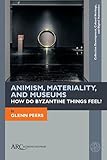Animism, Materiality, and Museums : How Do Byzantine Things Feel?
Material type: ArticleLanguage: English Publication details: Arc Humanities Press 2021Description: 1 electronic resource (167 p.)ISBN:
ArticleLanguage: English Publication details: Arc Humanities Press 2021Description: 1 electronic resource (167 p.)ISBN: - CDH-9781942401742
Open Access star Unrestricted online access
Among our most cherished modern assumptions is our distance from the material world we claim to love or, alternately, to dominate and own. As both devotional tool and art object, the Byzantine icon is rendered complicit in this distancing. According to well-established theological and scholarly explanations, the icon is a window onto the divine: it focuses and directs our minds to a higher understanding of God and saints. Despite their material richness, icons are understood to efface their own materiality, thereby enabling us to do the same. That the privileged relation of image to God is based on its capacity for material self-effacement is the basis for all theology of the icon and all art-historical description. It gets more complicated than this definition, to be sure, but the icon is positioned in this way in most straightforward accounts, whether devotional or scholarly. My position is to undermine the transcendentalizing determination of modern theology and aesthetics, and to lean very heavily on the materiality of these things to the point of allowing them, to the degree I can, a voice and life of their own.
Creative Commons https://creativecommons.org/licenses/by-nc-nd/4.0/ cc https://creativecommons.org/licenses/by-nc-nd/4.0/
English
There are no comments on this title.

